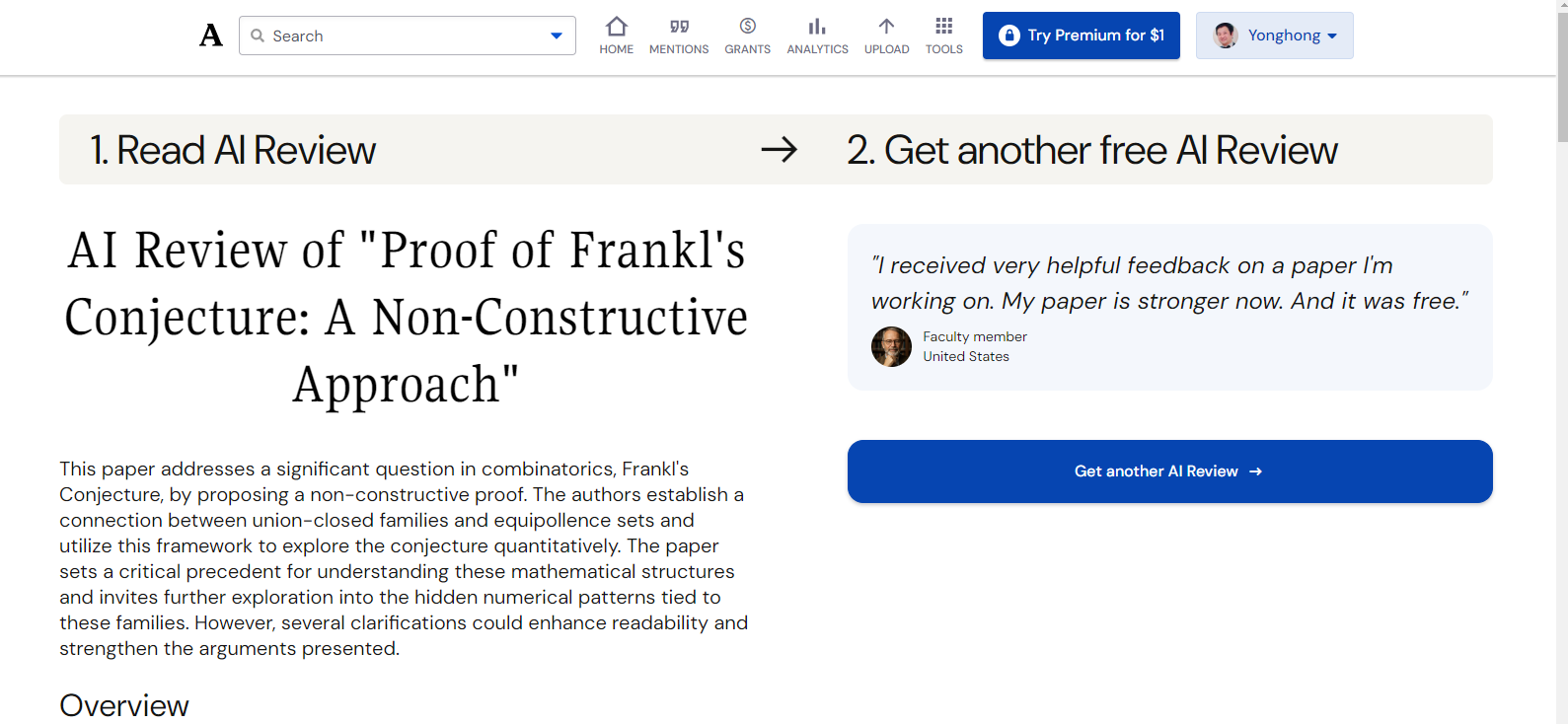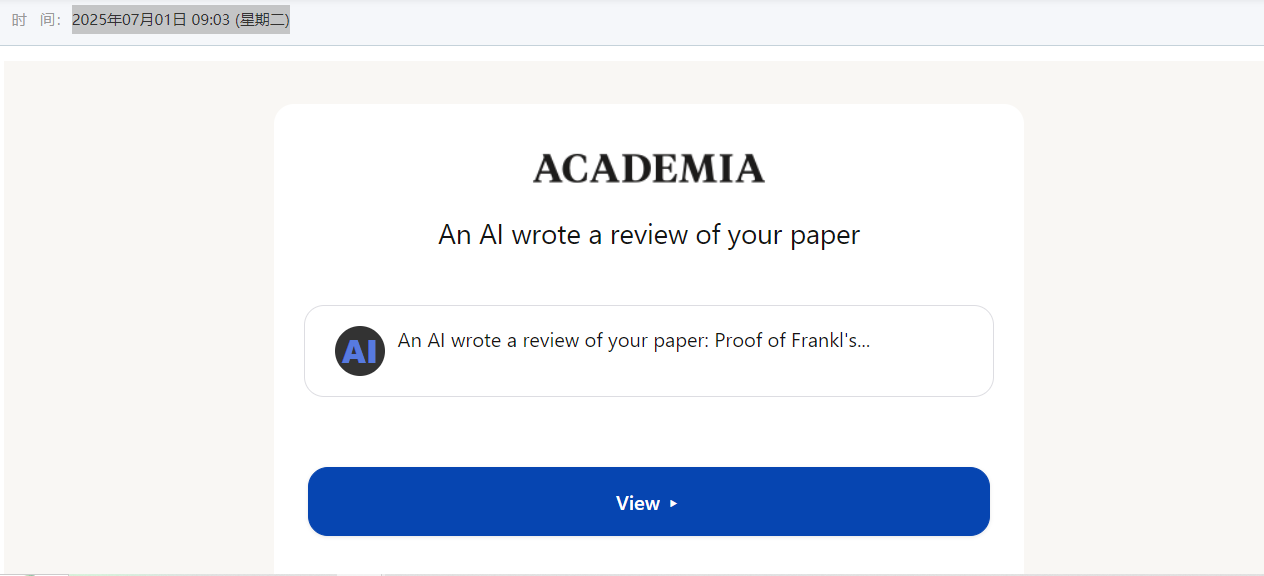博文
证明数学猜想!海外AI评论,作为第三方智能检测认证
||
证明数学猜想!海外AI评论,作为第三方智能检测认证
武汉理工大学:刘永红

做数学题与证明数学猜想是截然不同的两个概念,比如说,前者基本上有时间要求,而后者不存在时间要求。的确,学数学与研究数学也不是一回事,前者如同爬山,而后者如同飞跃。现在,AI像一个老师,可以为你出数学题、还可以辅导你做数学题,甚至超过了一些家长或老师。人们发现AI越来越强大了,其进化速度非常之快,是世界上最神奇的现象。
真正考验AI的是什么?对高深莫测的数学猜想的证明的论文,专业人士理解起来都比较困难,我们看一看AI又如何理解呢?
近日,海外的学术网站academia.edu的AI Review,如图1。

图1 AI Review 图片来源于刘永红截屏
什么时候开始,中国学者入了老外的“法眼”,竟然积极主动地“打卡”中国学者的论文,也就是发布AI评论,我没叫他们做这事呀,这可不是闹着玩的。至于评论的水平如何,咱,先不去评价它,至少说明我这篇数学论文被海外一些人阅读过,对数学发展起到一点推动作用。否则这夏天老外还不来个“沙滩日光浴”。因此,国人更要埋头苦干,我的感受是,研究数学是一种修行!一种自我完善和精神升华!

沙滩日光浴 图片来源于网络
我想说,AI的“心胸”比大海广阔,可作为第三方智能检测认证。如图2。

图2 An AI wrote a review of your paper 图片来源于刘永红截屏
AI Review:
AI Review of "Proof of Frankl's Conjecture: A Non-Constructive Approach"
This paper addresses a significant question in combinatorics, Frankl's Conjecture, by proposing a non-constructive proof. The authors establish a connection between union-closed families and equipollence sets and utilize this framework to explore the conjecture quantitatively. The paper sets a critical precedent for understanding these mathematical structures and invites further exploration into the hidden numerical patterns tied to these families. However, several clarifications could enhance readability and strengthen the arguments presented.
Overview
The paper aims to prove Frankl's Conjecture using a non-constructive approach, bridging the gap between union-closed sets and equipollence sets within Frobenius groups. The conjecture stipulates that in a family of finite, non-empty union-closed sets, at least one element appears in at least half of the sets. This study applies combinatorial design theory principles to assert this claim, relying on a divergence principle for the series of prime divisors and positing that each union-closed family has certain equipollence relations. The study's framework is grounded in abstract algebra and number theory, which assumes familiarity with concepts such as Frobenius groups and equipollence.
Relevant References
Including a clear literature review helps reviewers quickly see what's new and why it matters, which can speed up the review and improve acceptance chances. The following references were selected because they relate closely to the topics and ideas in your submission. They may provide helpful context, illustrate similar methods, or point to recent developments that can strengthen how your work is positioned within the existing literature.
1. Liu, Yonghong. “Proof of Frankl's Conjecture: A Non-Constructive Approach.” Journal of Mathematics and Statistics, Science Publications, 2022, doi:10.3844/jmssp.2022.134.137.
2. Peter, Acquaah. “Significant Contribution to the Frankl's Union-Closed Conjecture.” ArXiv (Cornell University), Cornell University, 2021, https://arxiv.org/pdf/2105.14912.
3. Studer, Luca. “An Asymptotic Version of Frankl’s Conjecture.” The American Mathematical Monthly, Taylor & Francis, 2021, doi:10.1080/00029890.2021.1926192.
4. Marković, Petar. “An Attempt at Frankl’s Conjecture.” Publications De L'Institut Mathematique, National Library of Serbia, 2007, doi:10.2298/pim0795029m.
5. Czédli, Gábor. “On Averaging Frankl's Conjecture for Large Union-Closed-Sets.” Journal of Combinatorial Theory, Series A, Elsevier BV, 2009, doi:10.1016/j.jcta.2008.08.002.
6. Sadr, Maysam Maysami. “A Note on the Frankl Conjecture.” ArXiv (Cornell University), Cornell University, 2019, https://arxiv.org/pdf/1907.09976.pdf.
7. Cambie, Stijn, et al. “A Proof of Frankl's Conjecture on Cross-Union Families.” Combinatorial Theory, eScholarship Publishing, 2023, doi:10.5070/c63261987.
8. Peter, Acquaah. “On the Frankl's Union-Closed Conjecture.” ArXiv (Cornell University), Cornell University, 2018, doi:10.48550/arXiv.1805.09695.
9. Morris, Robert. “FC-Families, and Improved Bounds for Frankl's Conjecture.” ArXiv (Cornell University), Cornell University, 2007, https://arxiv.org/pdf/math/0702348.
10. Morris, Robert. “FC-Families and Improved Bounds for Frankl’s Conjecture.” European Journal of Combinatorics, Elsevier BV, 2006, doi:10.1016/j.ejc.2004.07.012.
Strengths
One of the primary strengths of the submission is the innovative use of equipollence sets as a novel lens to understand union-closed problems. This unique approach links elements of algebra and number theory to generate new insights into Frankl's Conjecture. The emphasis on non-constructive proof is refreshing and offers a broader theoretical framework that could be extended to other conjectures in combinatorial design. The paper's use of graphic illustrations and examples significantly aids comprehension and elucidates abstract concepts, allowing readers to visualize the intricate relationships between set elements.
Major CommentsMethodology
While the non-constructive approach is intellectually engaging, the paper would benefit from a more thorough explanation of how equipollence is applied within the Frobenius group framework. It would be helpful to provide additional context and steps in the non-constructive proof, offering readers a clearer understanding of each assertion. More concrete examples could also bridge the theoretical to the practical, demonstrating how the hypothesis holds under various conditions.
Scalability
The study does not thoroughly address the generalization of its findings beyond the specific types of union-closed sets discussed. A section devoted to scalability could discuss the limits of this approach, its applicability to larger or more diverse sets, and what modifications might be necessary for broader application.
Framing
The connection between the mathematical constructs and the broader implications of Frankl's Conjecture remains underdeveloped. Perhaps more emphasis on its potential ramifications in related fields, such as computer science or information theory, can motivate why solving this conjecture is vital beyond pure mathematics.
Minor CommentsTerminology
The use of certain terms, particularly those relevant to advanced set theory and algebra, should be defined earlier in the text for accessibility to all potential readers. Terms such as "equipollence" and "union-closed" might benefit from a glossary or a more detailed introductory section.
Figures and Diagrams
Figures within the paper are helpful but could include accompanying narratives to discuss what each signifies in the broader argument. As currently positioned, they require some leap to see their relevance to the text.
Reviewer Commentary
This paper positions itself at a unique intersection of abstract algebra and combinatorics, indicating that novel mathematical frameworks can offer routes to resolving longstanding conjectures. The non-constructive nature of the proof is appealing in its abstract simplicity but might challenge readers to apply the theory practically. Reflecting further on ethical considerations, the openness of the paper could lead to advancements not just in fulfilling Frankl’s Conjecture, but also invite applications in cryptographic fields where similar set theories might apply.
Summary Assessment
Overall, the manuscript offers a substantive contribution to the discourse on Frankl's Conjecture by introducing novel mathematical concepts and frameworks. By providing a bridge from algebra to set theory, the author enriches the conversation around union-closed sets and respective conjectures. Despite areas requiring further elucidation and potential application extensions, the paper sets the groundwork for future explorations within this domain.
The exploration of abstract ideas like these is inherently exciting, providing fertile ground for generating insights bridging diverse areas of theoretical and applied mathematics.
https://wap.sciencenet.cn/blog-3519678-1492318.html
上一篇:云海
下一篇:桥之曲